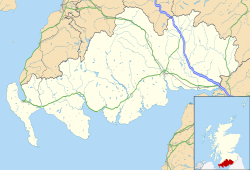
Back Dumfries and Galloway AST Dumfries and Galloway BAR Дъмфрис и Галоуей Bulgarian Dùn Phrìs is Gall-Ghaidhealaibh Breton Dumfries i Galloway Catalan Dumfries and Galloway CEB Dumfries a Galloway Czech Dumfries a Galloway Welsh Dumfries and Galloway Danish Dumfries and Galloway German
Dumfries and Galloway
| |
|---|---|
 Dumfries and Galloway shown within Scotland | |
| Coordinates: 55°06′N 3°54′W / 55.1°N 3.9°W | |
| Sovereign state | United Kingdom |
| Country | Scotland |
| Lieutenancy areas | |
| Unitary authority | 1 April 1996 |
| Administrative HQ | County Buildings, Dumfries |
| Government | |
| • Type | Council |
| • Body | Dumfries and Galloway Council |
| • Control | No overall control |
| Area | |
| • Total | 2,481 sq mi (6,426 km2) |
| • Rank | 3rd |
| Population (2022)[2] | |
| • Total | 145,770 |
| • Rank | 14th |
| • Density | 60/sq mi (23/km2) |
| Time zone | UTC+0 (GMT) |
| • Summer (DST) | UTC+1 (BST) |
| ISO 3166 code | GB-DGY |
| GSS code | S12000006 |
| Website | dumgal |
Dumfries and Galloway (Scots: Dumfries an Gallowa; Scottish Gaelic: Dùn Phrìs is Gall-Ghaidhealaibh) is one of the 32 unitary council areas of Scotland, located in the western part of the Southern Uplands. It is bordered by East Ayrshire, South Ayrshire, and South Lanarkshire to the north; Scottish Borders to the north-east; the English county of Cumbria, the Solway Firth, and the Irish Sea to the south, and the North Channel to the west. The administrative centre and largest settlement is the town of Dumfries. The second largest town is Stranraer, located 76 miles (122 km) to the west of Dumfries on the North Channel coast.
Dumfries and Galloway corresponds to the historic shires of Dumfriesshire, Kirkcudbrightshire, and Wigtownshire, the last two of which are collectively known as Galloway. The three counties were combined in 1975 to form a single region, with four districts within it. The districts were abolished in 1996, since when Dumfries and Galloway has been a unitary local authority. For lieutenancy purposes, the area is divided into three lieutenancy areas called Dumfries, Wigtown, and the Stewartry of Kirkcudbright, broadly corresponding to the three historic counties.
- ^ "Council and democracy". Dumfries and Galloway Council. Retrieved 15 September 2024.
- ^ a b "Mid-Year Population Estimates, UK, June 2022". Office for National Statistics. 26 March 2024. Retrieved 3 May 2024.
